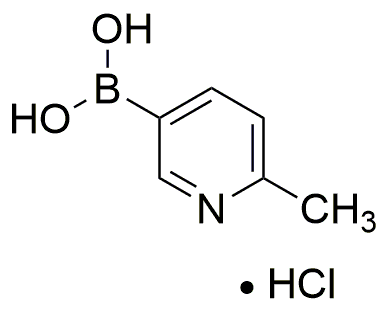2-Methylpyridine-5-boronic acid hydrochloride is widely utilized in research focused on:
- Organic Synthesis: This compound serves as a versatile building block in the synthesis of various organic molecules, particularly in the development of pharmaceuticals and agrochemicals.
- Cross-Coupling Reactions: It is commonly used in Suzuki-Miyaura coupling reactions, allowing for the formation of carbon-carbon bonds, which is essential in creating complex organic structures.
- Bioconjugation: The boronic acid functionality enables selective binding to diols, making it useful in bioconjugation processes for drug delivery systems and targeted therapies.
- Material Science: This compound is applied in the development of advanced materials, including sensors and catalysts, due to its unique chemical properties that enhance performance.
- Analytical Chemistry: It is utilized in various analytical techniques, such as chromatography, to improve the separation and detection of biomolecules, aiding in research and quality control.
General Information
Properties
Safety and Regulations
Applications
2-Methylpyridine-5-boronic acid hydrochloride is widely utilized in research focused on:
- Organic Synthesis: This compound serves as a versatile building block in the synthesis of various organic molecules, particularly in the development of pharmaceuticals and agrochemicals.
- Cross-Coupling Reactions: It is commonly used in Suzuki-Miyaura coupling reactions, allowing for the formation of carbon-carbon bonds, which is essential in creating complex organic structures.
- Bioconjugation: The boronic acid functionality enables selective binding to diols, making it useful in bioconjugation processes for drug delivery systems and targeted therapies.
- Material Science: This compound is applied in the development of advanced materials, including sensors and catalysts, due to its unique chemical properties that enhance performance.
- Analytical Chemistry: It is utilized in various analytical techniques, such as chromatography, to improve the separation and detection of biomolecules, aiding in research and quality control.
Documents
Safety Data Sheets (SDS)
The SDS provides comprehensive safety information on handling, storage, and disposal of the product.
Product Specification (PS)
The PS provides a comprehensive breakdown of the product’s properties, including chemical composition, physical state, purity, and storage requirements. It also details acceptable quality ranges and the product's intended applications.
Certificates of Analysis (COA)
Search for Certificates of Analysis (COA) by entering the products Lot Number. Lot and Batch Numbers can be found on a product’s label following the words ‘Lot’ or ‘Batch’.
Numéro de catalogue
Numéro de lot/série
Certificates Of Origin (COO)
This COO confirms the country where the product was manufactured, and also details the materials and components used in it and whether it is derived from natural, synthetic, or other specific sources. This certificate may be required for customs, trade, and regulatory compliance.
Numéro de catalogue
Numéro de lot/série
Safety Data Sheets (SDS)
The SDS provides comprehensive safety information on handling, storage, and disposal of the product.
DownloadProduct Specification (PS)
The PS provides a comprehensive breakdown of the product’s properties, including chemical composition, physical state, purity, and storage requirements. It also details acceptable quality ranges and the product's intended applications.
DownloadCertificates of Analysis (COA)
Search for Certificates of Analysis (COA) by entering the products Lot Number. Lot and Batch Numbers can be found on a product’s label following the words ‘Lot’ or ‘Batch’.
Numéro de catalogue
Numéro de lot/série
Certificates Of Origin (COO)
This COO confirms the country where the product was manufactured, and also details the materials and components used in it and whether it is derived from natural, synthetic, or other specific sources. This certificate may be required for customs, trade, and regulatory compliance.


